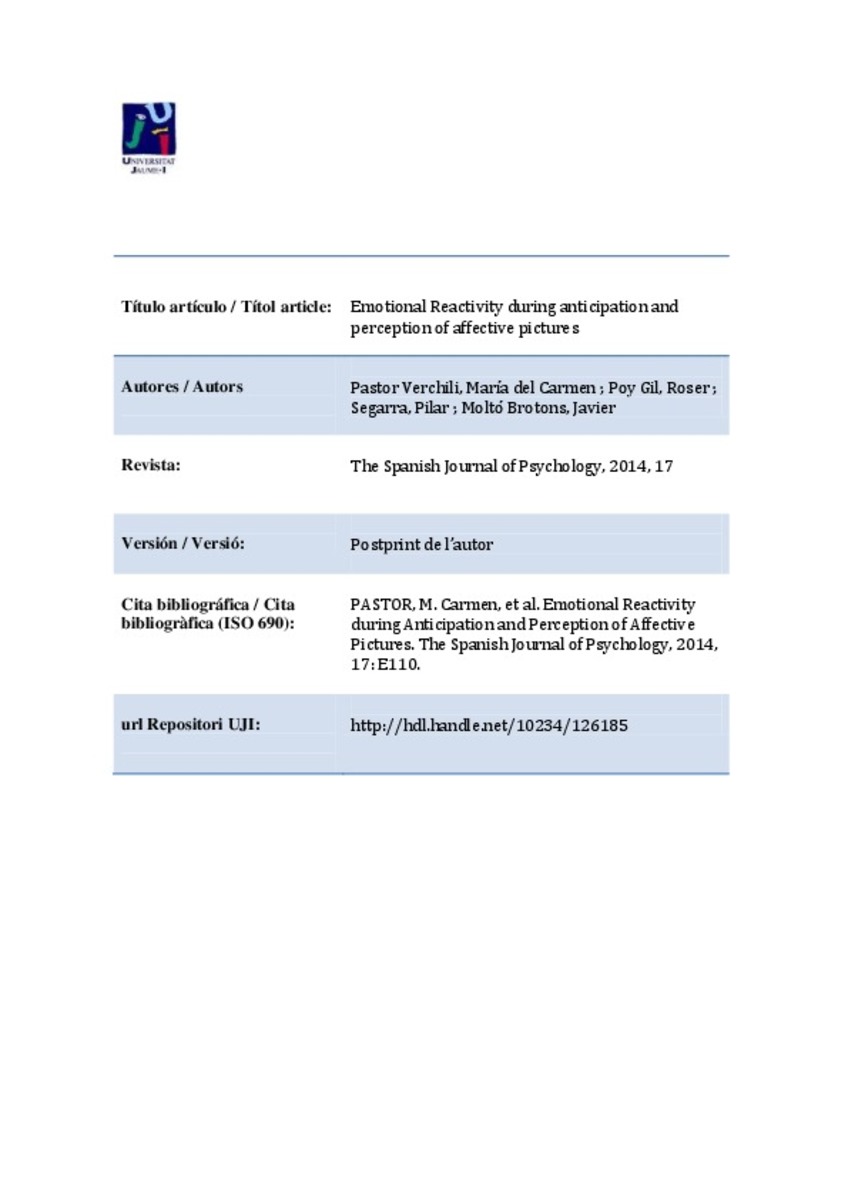Mostrar el registro sencillo del ítem
Emotional Reactivity during anticipation and perception of affective pictures
| dc.contributor.author | Pastor, M. Carmen | |
| dc.contributor.author | Poy, Rosario | |
| dc.contributor.author | Segarra, Pilar | |
| dc.contributor.author | Molto, Javier | |
| dc.date.accessioned | 2015-07-03T10:03:50Z | |
| dc.date.available | 2015-07-03T10:03:50Z | |
| dc.date.issued | 2014 | |
| dc.identifier.citation | PASTOR, M. Carmen, et al. Emotional Reactivity during Anticipation and Perception of Affective Pictures. The Spanish Journal of Psychology, 2014, 17: E110. | ca_CA |
| dc.identifier.uri | http://hdl.handle.net/10234/126185 | |
| dc.description.abstract | The focus of the present study was on further exploring anticipatory responses to emotional stimuli by measuring the eyeblink startle reflex in a variation of the picture-picture affective learning procedure. Participants (113 undergraduate women) were not explicitly instructed before the experiment began. Instead, they had to learn the specific relations between cues (geometrical shapes) and emotional pictures based on pairings during the first part of the task. Plausible contingency learning effects were tested afterwards, in a parallel sequence of trials including auditory probes during cues and pictures processing during the second part of the task. Results did show the typical affective startle modulation pattern during perception, linear F(1, 200) = 52.67, p < .0001, but unexpected inhibition for both pleasant and unpleasant, compared to neutral cues, during anticipation, quadratic F(1, 200) = 7.07, p < .009. All patterns of startle modulation were independent of cue-picture contingency awareness (all interactions Fs < 1). Skin conductance changes showed the predictable quadratic trend either during picture perception or anticipatory periods (greater activity for emotional vs. neutral; overall quadratic F(1, 224) = 7.04, p < .01), only for participants fully aware of the cue-picture contingency, quadratic F(1, 158) = 5.86, p < .02. Overall, our results during anticipation (cues processing) seem to suggest that more resources were allocated to highly arousing pictures that engage attention. Differences between the present results and prior research may be attributed to procedural variations in the sample, cues, or instructions. Future studies should also explore in more detail the role of the contingency awareness during anticipation. | ca_CA |
| dc.format.extent | 10 p. | ca_CA |
| dc.format.mimetype | application/pdf | ca_CA |
| dc.language.iso | eng | ca_CA |
| dc.publisher | Cambridge University Press | ca_CA |
| dc.relation.isPartOf | The Spanish Journal of Psychology, 2014, 17 | ca_CA |
| dc.rights | Copyright © Universidad Complutense de Madrid and Colegio Oficial de Psicólogos de Madrid 2014 | ca_CA |
| dc.rights.uri | http://rightsstatements.org/vocab/InC/1.0/ | * |
| dc.subject | emotion | ca_CA |
| dc.subject | anticipation | ca_CA |
| dc.subject | startle reflex | ca_CA |
| dc.subject | skin conductance | ca_CA |
| dc.subject | affective pictures | ca_CA |
| dc.title | Emotional Reactivity during anticipation and perception of affective pictures | ca_CA |
| dc.type | info:eu-repo/semantics/article | ca_CA |
| dc.identifier.doi | http://dx.doi.org/10.1017/sjp.2014.106 | |
| dc.rights.accessRights | info:eu-repo/semantics/openAccess | ca_CA |
| dc.relation.publisherVersion | http://journals.cambridge.org/action/displayAbstract?fromPage=online&aid=9512088&fileId=S1138741614001061 | ca_CA |
| dc.type.version | info:eu-repo/semantics/acceptedVersion | ca_CA |
Ficheros en el ítem
Este ítem aparece en la(s) siguiente(s) colección(ones)
-
PSB_Articles [1302]
Articles de publicacions periòdiques







